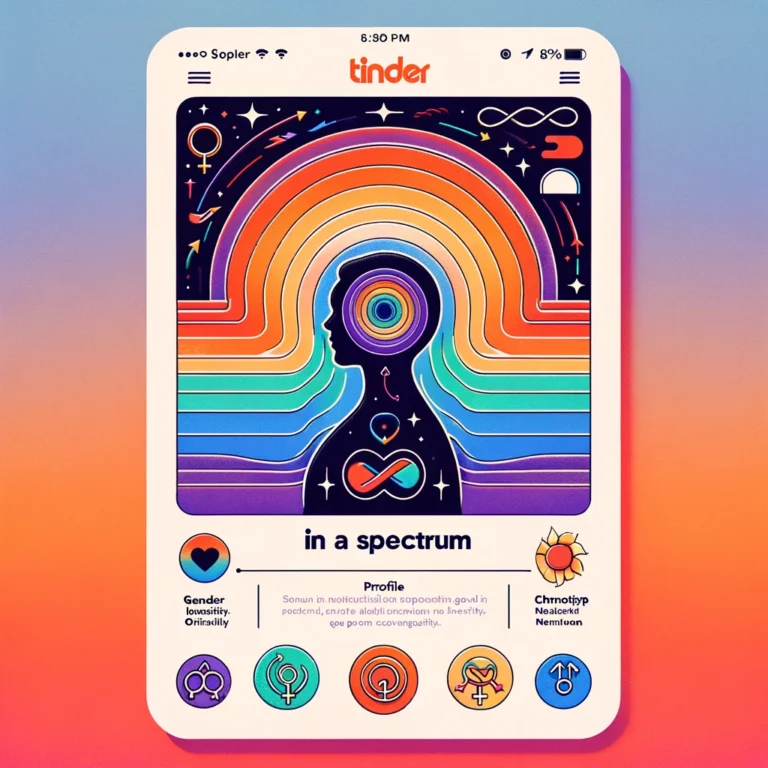So you’ve been swiping on Tinder and you come across an intriguing profile with the “In a Spectrum” tag.
What exactly does that mean? This label can signify different things to different users.
So, let’s peel back its layers of meaning so you can start an informed conversation.
The Gender and Sexuality Spectrums
For many Tinder users, “In a Spectrum” indicates that they don’t conform to the traditional gender binary of male/female or sexual orientation binaries of gay/straight. Instead, they feel their gender identity or sexual preferences flow across a wide spectrum of possibilities.
Understanding Gender Complexity
Gender isn’t always as cut and dry as male or female. Many people feel their inner sense of gender exists on a spectrum, meaning they may identify as:
- Non-binary (neither exclusively male nor female)
- Genderfluid (moving between genders)
- Gender expansive (broadening cultural gender expressions)
- Agender (feeling no gender applies to them)
Or any number of identities in between.
Some believe gender itself is merely a societal construct that categorizes behavior as masculine or feminine. Identities across the gender spectrum demonstrate that self-expression can be much more nuanced.
Exploring Sexual Attraction

Similarly, sexual attraction and romantic connections often transcend society’s typical binary system. Straight, gay, and lesbian don’t encapsulate everyone’s experience.
For example, people who are bisexual or pansexual have the capacity to be attracted to more than one gender. Their feelings may fluctuate over time, encompassing both male and female attractions or existing outside of the gender binary altogether.
The split between sexual and romantic orientation also factors in. You may find yourself physically attracted to men but emotionally drawn to women or vice versa.
For many open-minded singles, checking the “In a Spectrum” box signals they understand attraction takes limitless forms they’re eager to explore together.
Neurodiversity and the Autism Spectrum
The “In a Spectrum” label can also indicate that someone identifies as autistic or neurodivergent.
Autism Spectrum Disorder (ASD) refers to a range of developmental differences related to how people communicate, behave socially, learn, focus their attention, and process sensory information.
Because symptoms vary so widely across cognitive and emotional processing styles, support needs, and ability ranges, autism is often visualized as a color wheel with infinite shades rather than a linear set of defined points.
Embracing neurodiversity, some singles use “In a Spectrum” to connect with matches who grasp their unique passions or needs. Understanding goes a long way.
Spectrums of Sleep
We’ve covered spectrums related to gender, sexuality, and autism so far. But you may still be wondering—what’s up with that cryptic sunrise image paired with the “In a Spectrum” tag?
This visual actually hints at another spectrum frequently marked by this label: chronotype spectrums capturing preferences and patterns around sleep cycles.
In chronobiology, spectrums relate to whether individuals identify as morning larks (early risers), night owls (preferring late nights), or various shades in between like afternoon doves. The sunrise icon mirrors language referring to larks catching the “early bird” while owls are still awake to see the “late night” hours.
So if you run into the sunrise emblem and “In a Spectrum” on Tinder, your match may simply be conveying their place on the chronotype spectrum, perhaps as a nocturnal night owl staying up burning the midnight oil!
Starting an Open Conversation

Ultimately, the only way to know for sure what “In a Spectrum” indicates to a particular Tinder match is to ask.
If you come across the tag, start a conversation. Be politely curious, not judgmental.
You could say “I noticed your ‘In a Spectrum’ tag – would you feel comfortable telling me a bit about what that means for you?”
Or, “The ‘In a Spectrum’ label caught my eye. I’d love to know more about how you self-identify if you’re open to sharing.”
Look at it as a chance to understand the rich dimensions of human identity. Listen, ask questions if appropriate, and share about yourself as well.
When we relate to one another with compassion, we take the first step to building a more inclusive world for all.
Fostering Connection Across the Spectrum
Tinder presents a powerful platform for meeting open-hearted people from all walks of life. While profiles offer just a snippet of who someone is, that’s the fun – discovering the fuller picture through friendly conversation.
Being Your True Self
If you feel you reside outside the lines of traditional gender expectations or attraction norms, consider adding an “In a Spectrum” tag to welcome matches intrigued to know more about your unique essence.
Be clear in your bio about how you self-identify. Spell out your preferred pronouns, share your passions, and hint at quirks others might appreciate about you.
The right person will be eager to embrace the special shades that make you.
Finding Common Ground
Even if the “In a Spectrum” designation doesn’t define your own identity, it can serve as a meaningful talking point.
Ask respectful questions to better grasp what a match means when they use the label. Listen earnestly to understand their experiences.
You might discover shared interests and values that resonate despite any differences. Or simply gain insight that makes the world seem a little less strange and hostile.
It Starts with Curiosity
Regardless of how you tick the boxes, choosing “In a Spectrum” demonstrates an admirable quality: curiosity.
It shows you’re willing to look beyond surface impressions in search of deeper connections. And that you embrace the beautifully messy diversity of humanity.
When singles enter conversations with that insightfulness and compassion, exciting relationships unfold organically. Moments of discovery lead to empathy. Empathy leads to respect. Respect paves the way for affection.
So if you spot that “In a Spectrum” tag, recognize it as an opportunity. A chance to open your mind, hear someone’s story, and find the common threads that bind us all together.

